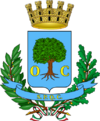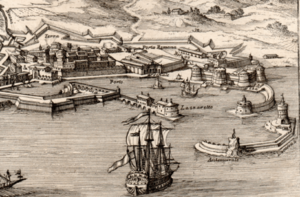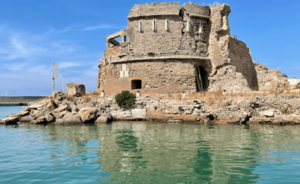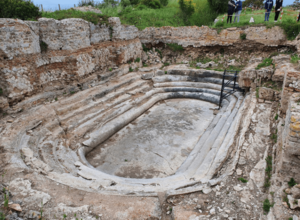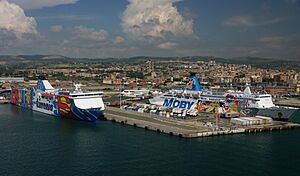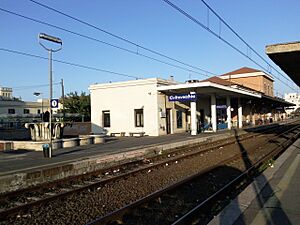Civitavecchia facts for kids
Quick facts for kids
Civitavecchia
|
|||
|---|---|---|---|
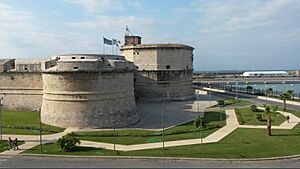
Civitavecchia fort and harbour
|
|||
|
|||
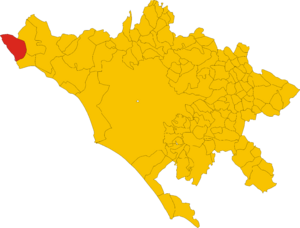
Location in the Metropolitan City of Rome
|
|||
| Country | Italy | ||
| Region | Lazio | ||
| Frazioni | Aurelia, La Scaglia | ||
| Time zone | UTC+1 (CET) | ||
| • Summer (DST) | UTC+2 (CEST) | ||
| Patron saint | Saint Fermina | ||
Civitavecchia is a lively city and a very important sea port in Italy. It's located on the Tyrrhenian Sea, about 60 kilometers (37 miles) west-northwest of Rome. The name "Civitavecchia" means "ancient town," which tells you a lot about its long history! It's a comune (like a town or municipality) within the Metropolitan City of Rome.
The city's harbor is a busy place, protected by two piers and a long breakwater where a lighthouse stands tall. It's a key gateway for travelers and goods moving across the Mediterranean Sea.
Contents
History of Civitavecchia
Ancient Times: Etruscans and Romans
The area around Civitavecchia has many signs of the ancient Etruscans. It's thought that a small Etruscan village once stood where the city is now. They built tombs, like the Mattonara necropolis, which are over 2,600 years old! There was even an early port with small basins for single boats.
The Romans later built amazing baths called Terme Taurine nearby. These were like ancient spas where people could relax in warm waters.
The harbor became much bigger and more important thanks to the Roman Emperor Trajan around 107 AD. He named it Centum Cellae, which means "hundred cells." This name might have come from the many arched "cells" that made up the harbor wall, or perhaps from the hundred rooms of Trajan's huge villa nearby. Trajan's favorite architect, Apollodorus of Damascus, probably designed this impressive harbor.
This area was so important that Emperor Trajan even held special meetings there, showing it was a significant imperial residence. Later, young Marcus Aurelius and Commodus also used the villa.
Ancient writings found in a cemetery near the harbor show that sailors from the Roman navy lived here. This proves how busy and important the port was for the Roman Empire.
In 251 AD, Pope Cornelius was held prisoner in Centumcellae during a time when Christians were persecuted. He died there in 253 AD.
By the 4th and 5th centuries, Civitavecchia (then Centumcellae) was a very busy port for Rome. This was because Rome's main port, Ostia, was becoming too shallow with silt.
Later History: From Byzantines to Papal States
In the 530s, Centumcellae was a strong point for the Byzantine Empire. It faced many battles between the Goths and the Byzantines.
The city became part of the Papal States in 728 AD. Pope Gregory III made its defenses stronger. However, the port was attacked many times by the Saracens (pirates from the Middle East) in the 9th century. Because of these attacks, a new, safer settlement was planned. But people eventually returned to the old town by the sea in 889 AD and rebuilt it, calling it Civitas Vetus – the "Old City."
Over time, different local lords ruled Civitavecchia. But in 1431, Pope Eugene IV sent an army to take it back, and it became a full Papal possession again.
In 1696, Pope Innocent XII made Civitavecchia a "free port," meaning ships could trade there without paying certain taxes. This helped it become the main port for Rome.
The French Empire took control of Civitavecchia in 1806. A famous French writer, Stendhal, even served as a consul (a government official) there for a while.
In 1859, the railway line connecting Rome and Civitavecchia was opened, making travel and trade much easier.
In 1870, the port officially became part of Italy, no longer under Papal control.
During World War II, Civitavecchia was bombed by the Allies, causing damage to the city and harming many people.
Economy
Today, Civitavecchia is a very important port for cruise ships and ferry boats. It's the main place in central Italy to catch a ferry to places like Sardinia, Sicily, Tunis, and Barcelona. Fishing is also important, but less so than the port activities.
The city also has two large power stations. There have been some concerns and protests from people about converting one of them to use coal, as they worry it could cause a lot of pollution.
Main Sights
Roman City Remains
The modern inner harbor of Civitavecchia is built on ancient Roman foundations. You can still see many of these old structures, and the harbor's shape is much like it was in Emperor Trajan's time. It had curved and straight breakwaters with arches to calm the waves, and some of these arches are still there!
The Torre di Lazzaretto is a remaining Roman tower that once served as a beacon (a light or signal) for ships entering the ancient harbor. You can also see parts of old Roman warehouses near the harbor.
A section of the ancient Roman road, the Via Aurelia, has been found running along the harbor. It was 6 meters (20 feet) wide! Parts of the Roman city wall can also be seen in the basements of some buildings. There are also remains of an aqueduct (a water channel) and a large cistern (a water storage tank), which might have been part of Trajan's grand villa.
North of the city, you can visit the Terme Taurine baths. These were popular with Romans and are still enjoyed by people from Civitavecchia today. The modern name comes from the fig trees that grow around the pools.
Even older baths, called Aquae Tauri, from the Etruscan and early Roman times, are also nearby at Ficoncella.
Other Interesting Places
The huge Forte Michelangelo (Michelangelo's Fort) was first ordered by Pope Julius II to protect Rome's port. The very top part of its main tower was designed by the famous artist Michelangelo, which is why the fort is named after him! Later, other popes added a prison and an arsenal (a place to store weapons).
Many large cruise ships use Civitavecchia as a starting or ending point for their journeys. Other cruises stop here so passengers can take a quick trip to visit Rome and the Vatican, which are only about 90 minutes away.
Geography
Civitavecchia has a hot-summer Mediterranean climate. This means it has hot, dry summers and mild, wet winters, similar to many places around the Mediterranean Sea.
Transport
The Port of Civitavecchia, often called the "Port of Rome," is a very important place for sea travel and moving goods in Italy. It's part of the "Motorways of the Sea" network, connecting Italy to many other ports around the Mediterranean Sea. It's one of the main ways to get from mainland Italy to Sardinia.
The Civitavecchia railway station opened in 1859. It's the end point of the Rome–Civitavecchia railway, which is part of a larger railway line connecting Pisa, Livorno, and Rome.
Civitavecchia is also served by the A12 motorway, which connects Rome to Genoa. The State highway SS1 Via Aurelia also passes through the town. There's also a project for a new motorway, sometimes called the New Romea, which will connect Civitavecchia to Venice.
Education
Civitavecchia has many schools for children of all ages, including preschools, primary schools, junior high schools, and high schools. There's also a university center, Polo Universitario di Civitavecchia, for older students.
Twin towns and sister cities
Civitavecchia has special friendships with other cities around the world. These are called "twin towns" or "sister cities." They often share cultural exchanges and learn from each other. Civitavecchia is twinned with:
 Amelia, Italy
Amelia, Italy Bethlehem, Palestinian Authority, since 2000
Bethlehem, Palestinian Authority, since 2000 Ishinomaki, Japan
Ishinomaki, Japan Nantong, China
Nantong, China
See also
 In Spanish: Civitavecchia para niños
In Spanish: Civitavecchia para niños



